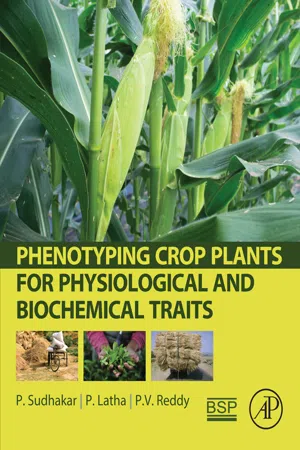
eBook - ePub
Phenotyping Crop Plants for Physiological and Biochemical Traits
This is a test
- 194 pages
- English
- ePUB (mobile friendly)
- Available on iOS & Android
eBook - ePub
Phenotyping Crop Plants for Physiological and Biochemical Traits
Book details
Book preview
Table of contents
Citations
About This Book
Phenotyping Crop Plants for Physiological and Biochemical Traits presents a proven range of methodologies and practices for effective, efficient, and appropriate typing of crop plants. By addressing the basic principles and precautions needed when conducting crop-based experiments, this book guides the reader in selecting the appropriate method based on the growing environment, whether greenhouse, pot, field, or liquid (hydroponic). By addressing the quantification of seed traits related to growth experiments, including their viability and vigor, this book presents methodology options for optimum yield based on potential abiotic stresses.
- Discusses various methods that can contribute to phenotyping of crop plants for various physiological and biochemical traits
- Presents reliable techniques for phenotyping or quantifying plant characters during varied climatic conditions
- Provides insights for selecting appropriate methodologies for specific crop growing situations
- Identifies the most appropriate protocols and methods for analyzing crop traits
Frequently asked questions
At the moment all of our mobile-responsive ePub books are available to download via the app. Most of our PDFs are also available to download and we're working on making the final remaining ones downloadable now. Learn more here.
Both plans give you full access to the library and all of Perlego’s features. The only differences are the price and subscription period: With the annual plan you’ll save around 30% compared to 12 months on the monthly plan.
We are an online textbook subscription service, where you can get access to an entire online library for less than the price of a single book per month. With over 1 million books across 1000+ topics, we’ve got you covered! Learn more here.
Look out for the read-aloud symbol on your next book to see if you can listen to it. The read-aloud tool reads text aloud for you, highlighting the text as it is being read. You can pause it, speed it up and slow it down. Learn more here.
Yes, you can access Phenotyping Crop Plants for Physiological and Biochemical Traits by P. Sudhakar,P. Latha,PV Reddy in PDF and/or ePUB format, as well as other popular books in Technology & Engineering & Agronomy. We have over one million books available in our catalogue for you to explore.
Information
References
A.O.A.C., 1960. Official and tentative method of analysis A.O.A.C. Washington, DC.
Vigour determination in soybean seed by multiple criteria. Crop Sci. 1973;13:630–633.
Acorbic acid and retention in lettuce. J. Food Qual. 1993;16:311–316.
Plant breeding and drought in C3 cereals: what should we breed for? Ann. Botany. 2002;89:925–940.
Copper enzymes in isolated chloroplasts: polyphenol oxidases in Beta vulgaris. Plant Physiol. 1949;24:1–14.
Production and action of active oxygen species in photosynthetic tissue. In: Foyer CH, Mullineaux PM, eds. Causes of Photooxidative Stress Amelioration of Defense Systems in Plants. Boca Raton, FL: CRC Press; 1994:77–104.
Screening of groundnut genotypes for high temperature tolerance. Plant Physiol. 2006;11(1):63–74.
Adaptation of the chlorophyll meter (SPAD) technology for real time N management in rice: a review. Int. Rice Res. Note...
Table of contents
- Cover
- Title page
- Table of Contents
- Copyright
- Message
- Foreword
- Preface
- Abbreviations
- Introduction
- Section I
- Section II
- Section III
- Section IV
- Section V
- Appendices
- References
- Index